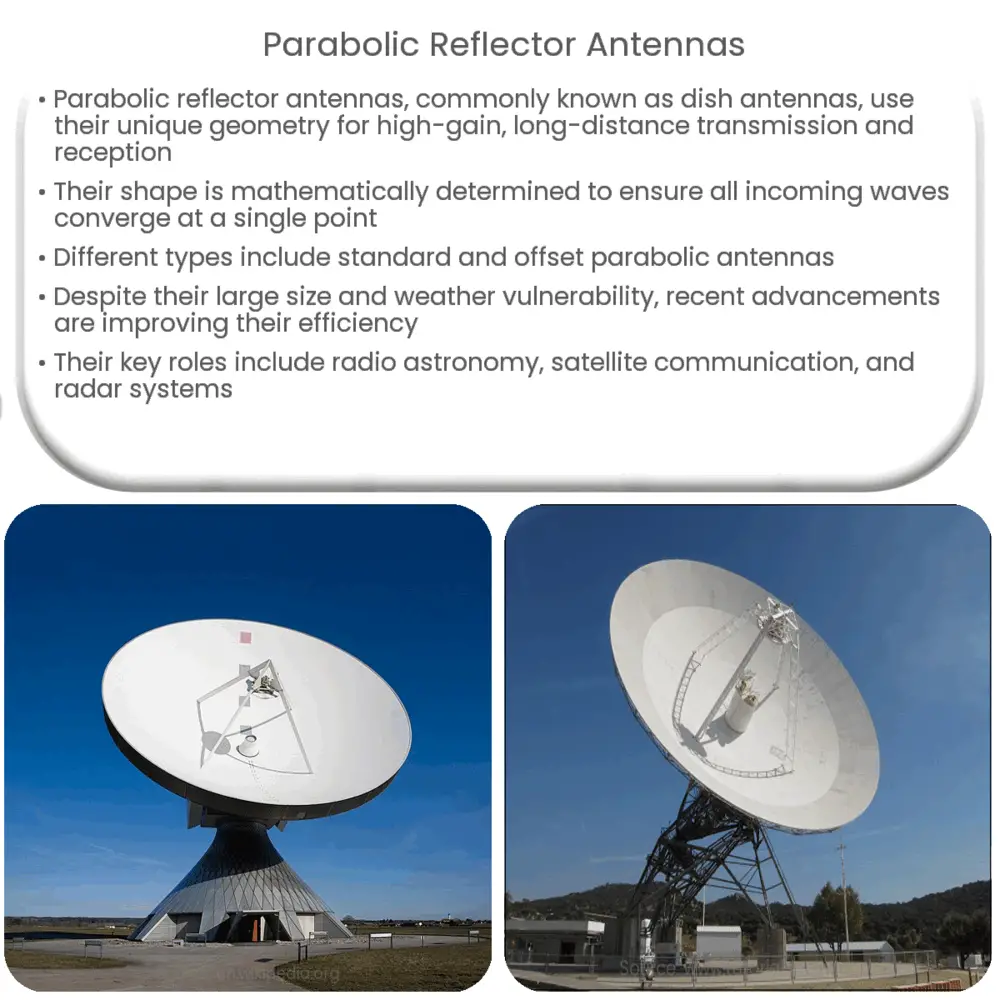Explore the world of parabolic reflector antennas: their design, working principle, applications, pros and cons, and recent advancements.

Introduction to Parabolic Reflector Antennas
Parabolic reflector antennas, often referred to as dish antennas or simply parabolic antennas, are high-gain antennas that are typically used for radio, television, and data communication. They work by collecting and focusing electromagnetic waves onto a single point, which allows for the transmission and reception of signals over great distances.
Understanding the Parabolic Shape
The parabolic shape of these antennas is not random; rather, it is born out of mathematical necessity. A parabola is a specific type of curve where any point is at an equal distance from a fixed point (the focus) and a fixed straight line (the directrix). This unique geometry enables the parabolic antenna to capture incoming radio waves and reflect them towards the focus, ensuring that all parallel beams that hit the antenna converge at the same point.
- Focus: The focal point of the parabola is where the receiver or transmitter is placed. All signals reflected from the parabolic dish come together at this point.
- Directrix: The directrix is not a physical part of the antenna but is a mathematical concept that defines the parabolic shape. All points on the parabola are equidistant from the focus and the directrix.
Types of Parabolic Antennas
There are several types of parabolic antennas, each suited to different applications.
- Front-Fed or Standard Parabolic Antenna: The most common design, where the feed antenna is located in front of the parabola, at the focus.
- Offset Parabolic Antenna: The feed antenna is located to one side of the parabola. This design reduces the amount of signal blocked by the feed but complicates the manufacturing and alignment processes.
Working Principle
Parabolic reflector antennas operate by converting incoming planar electromagnetic waves into spherical waves and vice versa. This is possible due to the unique geometry of the parabola. The key is to position the feed antenna at the focal point of the parabola, where all reflected signals come together. This allows for extremely high gain, making parabolic antennas ideal for long-distance communication.
Applications of Parabolic Antennas
Parabolic reflector antennas are versatile and have a broad range of applications. They are often used in radio astronomy for the detection and study of signals from outer space. These antennas are also commonly used in satellite communication, where high-gain antennas are required to transmit and receive signals over vast distances. Other applications include radar systems, wireless networking, and terrestrial microwave data links.
Advantages and Disadvantages
Like any technology, parabolic antennas have their pros and cons.
- Advantages: The main advantage of parabolic antennas is their high gain, which allows for long-distance communication. They also have a high directivity, which minimizes interference from unwanted sources.
- Disadvantages: On the downside, parabolic antennas are large and heavy, which can make them difficult to install and adjust. The performance of these antennas is also affected by the weather, as rain, snow, or high winds can degrade the signal.
Recent Developments
Recent advancements in materials and manufacturing technologies have enabled the development of smaller, lighter, and more efficient parabolic antennas. In particular, phased array technology has emerged as a promising alternative to traditional parabolic reflectors. Phased arrays can electronically steer the beam direction, enabling faster and more flexible communication.
Conclusion
In conclusion, parabolic reflector antennas are a key technology in many areas of communication, including radio astronomy, satellite communication, and radar systems. Their high gain and directivity make them ideal for long-distance communication. Although they have some disadvantages, such as their size and vulnerability to weather conditions, recent advancements in technology are helping to overcome these challenges and open up new possibilities. As we continue to explore the universe and expand our communication networks on Earth, parabolic antennas will undoubtedly continue to play a critical role.

